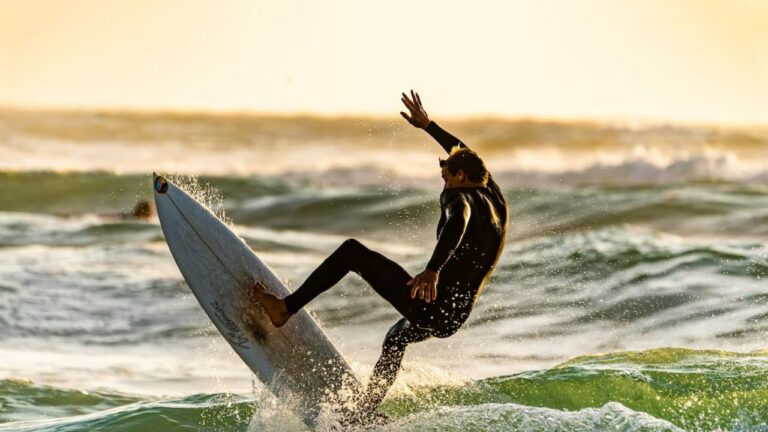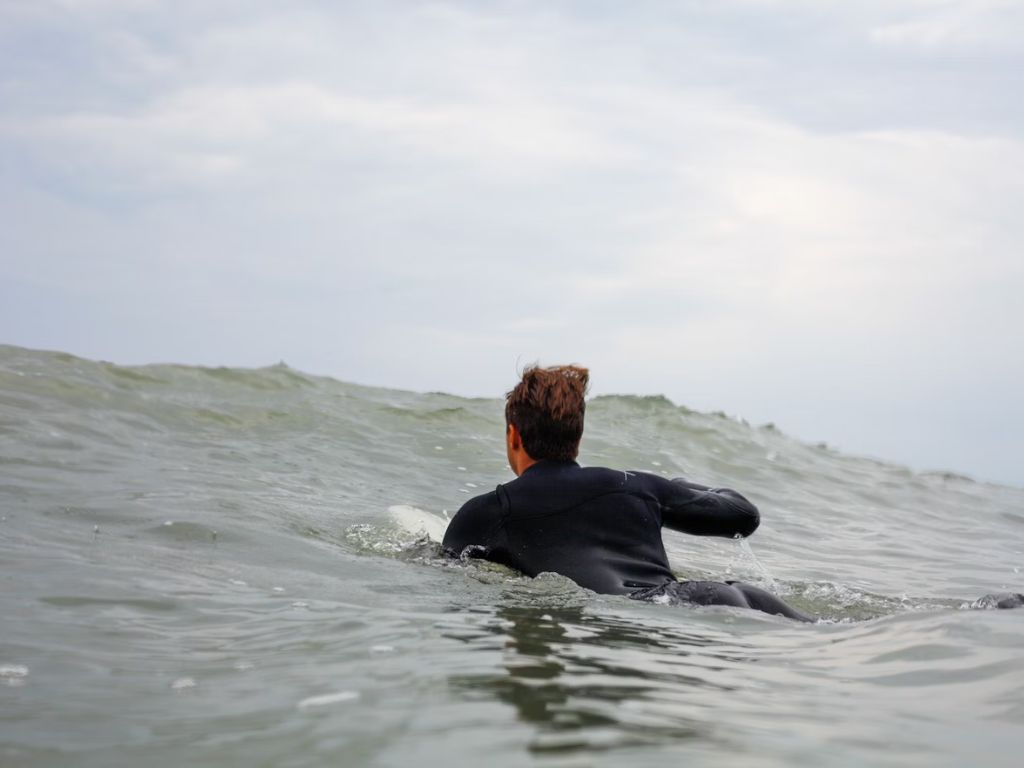After countless hours of riding waves, I can surely attest to the thrill and excitement of this incredible sport. Can surfing be dangerous? Yes. There is a good amount of danger involved in surfing. Does that mean you should let go of your passion? Of course not!
All you need to stay safe is to stay aware of your surroundings and practice proper surfing etiquette. Don’t underestimate the waves. I’ll expand more on staying safe in the article.
Newbie or pro, awareness regarding potential dangers is a must and, in most cases, life-saving. Staying safe involves proper knowledge of all potential dangers. Let’s look at some of those.
How common are surfing accidents?
Everything adventurous involves some dangers, but the risk of getting into an accident depends on different factors. For surfing, these factors include the location of the surf spot, the weather, the crowd as well as the experience of the surfer.
Generally, major surfing accidents aren’t all that common. According to National Safety Council, 2-3 drowning deaths per year in the United States can be attributed to surfing. However, the probability of minor accidents is higher than that.
The Epidemiology of Acute Injuries in Surfing study published in the Journal of Science and Medicine in Sport found that the injury rate for surfing was approximately 6.6 per 1000 hours. Luckily, this injury rate is much lower than in high-impact sports like basketball or football.
Common Dangers of Surfing
1. Drowning
Drowning claims the most lives when it comes to surfing. Despite having years of experience, I have been taken off guard by a strong undertow or powerful waves sometimes.
It is important always to be aware of your surroundings when in the water and to exercise caution. No matter how easy the wave looks, there is always room for an accident.

If you are pulled into the sea, stay calm and try to swim parallel to the shore and not against the current. I strongly recommend always wearing a life jacket or wetsuit while surfing; it helps keep the surfer afloat if they are struggling to stay above the surface.
2. Impact Injuries
Impact injuries are one of the biggest concerns for surfers, and they can happen when you fall off your board and collide with the bottom or sides of the wave, rocks, coral, or debris. These injuries range from minor cuts and bruises to even more serious fractures, ligament tears, and concussions.
Despite not being as deadly a threat as drowning, the consequences of impact injuries can be long-lasting, leading to chronic pain, nerve damage, and mobility problems.
One of the easiest and most effective ways to protect yourself from these is by always wearing a helmet when you’re out on the water. It might not be the most stylish accessory, but it could save you from a serious injury.
Remember, there’s no shame in taking precautions to protect yourself while doing what you love. So, grab your helmet and hit the waves with confidence!
3. Marine Life Encounters
Sharks and jellyfish, among other such sea creatures, pose a serious threat to surfers while in the ocean. Sharks, in particular, are known to be curious and can be attracted to the splashing of surfers. Jellyfish stings can also be extremely painful and sometimes even fatal.
You can minimize the risk of marine life encounters when surfing by being aware of your surroundings and noticing any signs of potentially dangerous creatures. If you spot a large animal in the water, avoiding it and heading to shore is best. Wearing a wetsuit can be a good way to protect yourself from jellyfish stings.
Another important precaution is staying in shallow waters, preferably areas with lifeguards on duty. Lastly, it is essential to be aware of local laws and regulations regarding marine life in the area.
If the thought of such encounters puts you off, remember– more people die of bee stings and lightning strikes than shark attacks.
4. Hypothermia
Hypothermia is a serious risk for surfers exposed to cold ocean water for extended periods. For the body to maintain a normal temperature, it needs to generate heat.
And when it’s exposed to cold water, the temperature drops as heat is lost faster than it can be generated. This rapid decrease in body temperature results in hypothermia.

Here’s a list of some signs and symptoms of hypothermia:
- Shivering
- Confusion
- Apathy
- Disorientation and loss of coordination
- Slurred speech
Always check the water temperature before entering, and wear a wetsuit appropriate for the water temperature. It is also important to take frequent breaks and get out of the water to warm up and dry off. You should never stay in the water for too long since extended exposure increases the risk of hypothermia.
5. Rocky Waterbed
With their unpredictable nature and potential for catastrophic collisions, Rocky waterbeds pose a significant threat to surfers’ safety.
These waterbeds are characterized by sharp and jagged rocks near the shoreline and beneath the water’s surface. While some of you may consider riding waves over rocky waterbeds as a thrilling experience, it can also result in severe injuries.
The ocean’s currents and tides constantly reshape the seabed, rendering yesterday’s familiar playground into today’s perilous trap.
The once-familiar path can transform into a maze of danger, with rocks jutting out in unexpected locations. From broken bones to deep lacerations, the consequences of such encounters can be severe, abruptly ending the thrill of the ride and leaving lasting scars.
How to stay safe when surfing?
1. Never surf alone
Surfing alone as the sun sets down the horizon may fill you with excitement, but remember that it might not be the best safety-wise. Surfing alone, as thrilling as it is, has its downsides. All existing risks are magnitudes higher in the absence of a helping hand.
The company of a fellow experienced surfer can be life-saving. You can even go surfing with your buddy or a group of friends. It will not only make the experience more fun, but it will also provide an extra layer of protection. Having someone to assist you or call for help can be a lifesaver in an emergency.

2. Learn about riptides
Riptides typically occur in areas with breaks in sandbars or jetties, and they often look like calm, flat areas of water amidst breaking waves. They’re difficult to spot, so knowing how to identify them before you hit the water is important.
One way to recognize a riptide is to look for a line of seaweed or debris moving away from shore. Another indication is a choppy or discolored water channel between two breaking waves. If you’re unsure, it’s always best to ask a lifeguard or a local surfer for advice on where it’s safe to surf or swim.
If this helps– riptides can be avoided altogether by paying attention to surf reports and avoiding the areas prone to riptides. But what to do if you get caught in a riptide?
Here’s your answer– Don’t try to swim against the current; instead, swim parallel to the shore until you’re out of the riptide’s pull. Once out of the current, swim towards the shore at an angle.
3. Communicate with your fellow surfers
The first step in communicating with fellow surfers is establishing clear signals and understanding each other’s meanings. One great way to communicate is through hand signals. For example, if you’re going for a wave, you can signal your intention by pointing toward it.
Similarly, if you’re giving up a wave, you can signal by waving your hand or paddling away. These are simple yet effective ways to convey your intentions and avoid collisions. Being aware of your surroundings and fellow surfers’ positions is also essential. Avoid surfing too close to each other, which can result in collisions or accidents.

4. Be aware of the surfing conditions
As I mentioned, take a moment to check the surf report before heading out. You’ll get all the wave height, wind conditions, and water temperature information. It makes it easier to choose the appropriate gear and decide whether the surf is safe.
Observing the conditions while you’re in the water is also important. Pay attention to the waves, the wind, and any currents. Also, keep your eyes peeled for things like bigger waves or changes in the wind direction or current.
5. Practice proper surf étiquettes
Surf etiquette is not just about being polite (although that’s always a good thing); it’s about respecting fellow surfers and creating a safe and fun environment for everyone. First off, respect the lineup. Don’t paddle around other surfers or try to sneak in front of them. Instead, wait your turn and give everyone a fair shot at catching a wave.
Next up, take turns. Don’t hog all the waves for yourself! Share the stroke and let others have a chance to catch some waves. And if you do catch a great wave, don’t be a wave hog by paddling back to the lineup and trying to catch another wave immediately.
Read this blog for a more detailed guide on staying safe and avoiding mishaps while surfing.
Expert QnA
Q. Is surfing a dangerous sport?
Surfing can pose certain risks and dangers due to the unpredictable nature of the ocean and the potential for accidents. However, with proper knowledge, skills, and precautions, the risks can be minimized, and surfing can be enjoyed safely.
Q. What should I do if I encounter a dangerous situation while surfing?
If you find yourself in a dangerous situation while surfing, try to remain calm and avoid panicking. Assess the situation and act accordingly. If possible, signal for help or swim to a safe area. It’s important to prioritize your safety and that of others around you.
Q. Can I surf alone or is it safer to have a buddy?
Surfing with a buddy is generally safer than surfing alone. Having someone with you increases the likelihood of prompt assistance in case of an emergency. Additionally, it allows for better awareness of each other’s positions in the water, reducing the risk of collisions.
Q. Are there any age restrictions for surfing?
Generally, there aren’t any strict age restrictions for surfing. However, it’s important to consider individual capabilities, experience, and the judgment of parents or guardians for younger surfers. It’s advisable to start with age-appropriate lessons and gradually progress under proper supervision.




